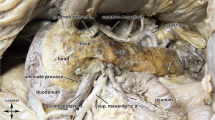Abstract.
Neuroendocrine tumours displaying somatostatin receptors have been successfully visualised with somatostatin receptor imaging (SRI). However, there may be differences in sensitivity depending on the site of the primary tumour and/or its metastases. We studied 131 patients affected by neuroendocrine tumours of the gastro-entero-pancreatic (GEP) tract. A pathological diagnosis was obtained in 116 patients, while in 15 the diagnosis was based on instrumental results and follow-up. Fifty-one patients were examined for staging purposes, 80 were in follow-up. Images were acquired 24 and 48 h after the injection of 150–220 MBq of indium-111 pentetreotide. Whole-body and SPET images were obtained in all patients. Patients were also studied with computed tomography (CT), ultrasound (US), and other procedures. Tumours were classified according to their site of origin: pancreas n = 39, ileum n = 32, stomach n = 16, appendix n = 9, duodenum n = 5, jejunum n = 5, rectum n = 3, biliary tract n = 2, colon n = 2, caecum n = 1, liver metastases from unknown primary = 15, widespread metastases from unknown primary = 2. Sensitivity for primary tumour localisation was as follows: SRI = 62%; CT = 43%; US = 36%; other procedures = 45%. Sensitivity for liver metastases: SRI = 90%; CT = 78%; US = 88%; other procedures = 71%. Sensitivity for the detection of extrahepatic soft tissue lesions was: SRI = 90%; CT = 66%; US = 47%; other procedures = 61%. Sensitivity for the detection of the primary tumour in patients with metastases from unknown primary sites: SRI 4/17; CT 0/13; US 0/12; other procedures 1/10. In 28% of the patients SRI revealed previously unknown lesions, and in 21% it determined a modification of the scheduled therapy. Our study confirms the important role of SRI in the management of GEP tumours. However, we feel that a critical investigation should address its role in locating primary tumours, in particular in patients with metastases from unknown primary sites.
Similar content being viewed by others
Author information
Authors and Affiliations
Additional information
Received 1 May and in revised form 29 June 1998
Rights and permissions
About this article
Cite this article
Chiti, A., Fanti, S., Savelli, G. et al. Comparison of somatostatin receptor imaging, computed tomography and ultrasound in the clinical management of neuroendocrine gastro-entero-pancreatic tumours. Eur J Nucl Med 25, 1396–1403 (1998). https://doi.org/10.1007/s002590050314
Issue Date:
DOI: https://doi.org/10.1007/s002590050314




